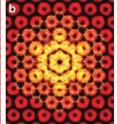Defect in graphene may present bouquet of possibilities
A class of decorative, flower-like defects in the nanomaterial graphene could have potentially important effects on the material's already unique electrical and mechanical properties, according to researchers at the National Institute of Standards and Technology (NIST) and Georgia Tech. In a new paper,* the team for the first time describes a family of seven defects that could occur naturally or be induced to occur in graphene, one of which already has been observed. Graphene is renowned for its strength and conductivity, both of which are a result of its structure. For the most part, graphene is a featureless plane of carbon atoms arranged in a honeycomb lattice.
According to NIST Fellow Joseph Stroscio, defects can appear due to the movement of the carbon atoms at high temperatures when producing graphene by heating silicon carbide under ultrahigh vacuum. The easiest, i.e. requiring the least amount of energy, rearrangements graphene can make are to switch from six-member carbon rings to rings containing five or seven atoms, which keeps all the carbon atoms happy with no unsatisfied bonds. The NIST researchers have discovered that stringing five and seven member rings together in closed loops creates a new type of defect or grain boundary loop in the honeycomb lattice.
According to NIST researcher Eric Cockayne, the fabrication process plays a big role in creating these defects.
"As the graphene forms under high heat, sections of the lattice can come loose and rotate," Cockayne says. "As the graphene cools, these rotated sections link back up with the lattice, but in an irregular way. It's almost as if patches of the graphene were cut out with scissors, turned clockwise, and made to fit back into the same place, only it really doesn't fit, which is why we get these flowers."
The exceedingly rigid lattice already is stronger than steel, but the defects might allow it a little flexibility, making it even more resilient to tearing or fracturing.
With more experimentation, Cockayne says, researchers should be able to correlate the appearance of defects with variations in growth conditions, which should make it possible to either avoid defects entirely or produce them at will.
Moreover, while the flower defect is composed of six pairs of five- and seven-atom rings, Cockayne and the NIST team's modeling of graphene's atomic structure suggests there might be a veritable bouquet of flower-like configurations. These configurations—seven in all—would each possess their own unique mechanical and electrical properties.
Source: National Institute of Standards and Technology (NIST)
Other sources
- Defect in graphene may present bouquet of possibilitiesfrom Science DailyWed, 25 May 2011, 17:30:42 UTC
- Defect in graphene may present bouquet of possibilitiesfrom PhysorgWed, 25 May 2011, 15:00:29 UTC
